Now - DawnSignPress
advertisement
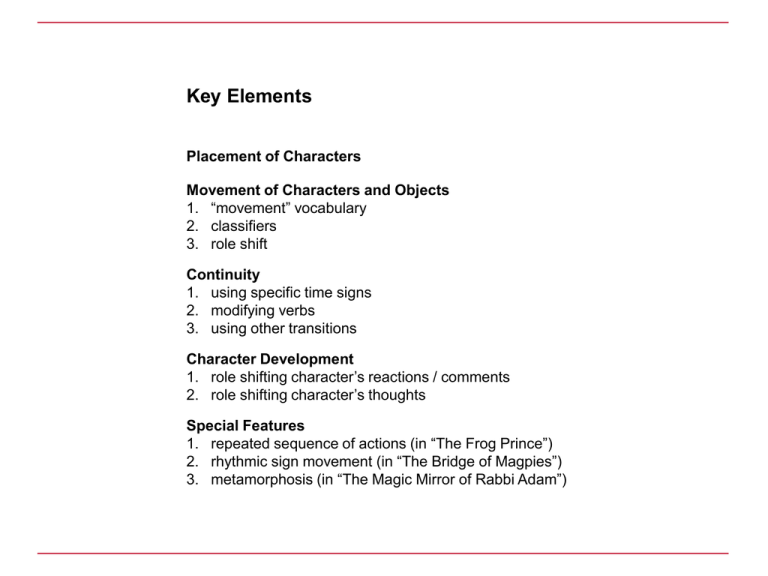
Key Elements Placement of Characters Movement of Characters and Objects 1. “movement” vocabulary 2. classifiers 3. role shift Continuity 1. using specific time signs 2. modifying verbs 3. using other transitions Character Development 1. role shifting character’s reactions / comments 2. role shifting character’s thoughts Special Features 1. repeated sequence of actions (in “The Frog Prince”) 2. rhythmic sign movement (in “The Bridge of Magpies”) 3. metamorphosis (in “The Magic Mirror of Rabbi Adam”) “The Twelve Dancing Princesses” INTRODUCTION Scene 1 Once upon a time there was a king who had twelve beautiful daughters. They slept in twelve beds in a single room. The king was jealous of his daughters and each night the door to their room was shut and bolted, but each morning when he unlocked the door, he noticed that their shoes had been danced to pieces, and nobody could explain how it happened. “The Twelve Dancing Princesses” INTRODUCTION Scene 2 The king declared that if any man discovered the secret of the worn-out shoes he could choose whichever princess he wanted for his wife. But whoever failed after three days would be put to death. Scene 3 A king’s son took up the challenge. In the evening of his arrival he was taken to the anteroom next to the princesses, to keep watch. His bed was made up there, and so that they could not do anything or leave without being seen, the door of the room was left open. But the eyes of the prince grew heavy and he fell asleep. In the morning he found the princesses’ shoes full of holes. The same thing happened the second night and also the third night. The prince was then granted no mercy, and the king ordered the prince’s head to be cut off. Other princes came but the same thing happened to all of them. BODY Scene 4 Now it happened that a poor soldier, who had been wounded and could no longer serve, found himself on the road to town where the king lived. There he fell in with an old woman who asked him where he intended to go. “I really don’t know,” he said. And he added in fun, “but I want to discover where the princesses dance and after that I should like to become king.” “Well, that is not so difficult,” said the old woman. “You must not drink the wine which the princesses will give you in the evening, and you must pretend to fall asleep.” Whereupon she gave him a short cloak, saying, “When you wear this you will be invisible, and then you can slip out after the twelve princesses.” Scene 5 When the soldier heard the good advice he considered it seriously, plucked up with courage to appear before the king, and offered himself as a suitor. He was as well received as the others and was dressed in royal garments. Scene 6 In the evening, when bedtime came, he was conducted to the anteroom. As he was about to go to bed the eldest princess appeared, bringing him a cup of wine. Secretly, he threw the wine away, and then he lay down and began to snore as though in deepest sleep. The twelve princesses heard him and laughed. The eldest said, “He too must forfeit his life.” Scene 7 Then they got up, opened cupboards, chests, and cases, and brought out their beautiful dresses. They decked themselves before the glass, skipping about and reveling in the prospect of the dance. Only the youngest sister said, “I don’t know what it is. You may rejoice, but I feel so uneasy.” “You are a little goose,” answered the eldest. “You are always frightened. Have you forgotten how many have come here in vain? Why, even without our sleeping potion the soldier would have slept soundly.” Scene 8 When they were all ready they looked in on the soldier to see that his eyes were shut and he did not stir. The eldest went up to one of the beds and knocked on it. It sank into the earth and they descended through the opening one after another, the eldest first. Scene 9 The soldier, who had noticed everything, did not hesitate long, but threw on his cloak and went down behind the youngest. In the middle of the stairway he accidentally trod on the gown of the youngest princess. She was frightened and said, “What was that? Who is holding on to my dress?” “Don’t be foolish. You must have caught it on a nail,” said the eldest. Scene 10 At the bottom of the stairs they found themselves at the entrance to a most delightful avenue of trees whose leaves were of glittering silver. The soldier thought, “I must take some token with me.” He broke off the twig, and a sharp crack came. “I am sure all is not right,” wailed the youngest. “Did you not hear the noise?” “It is only the sound of the fairy prince shouting for joy at our approach,” countered the eldest. Scene 11 Next they came to an avenue where all the leaves were of gold and to a third whose leaves were of glittering diamonds. From both the soldier broke off a twig, and there was a crack each time which made the youngest princess start with terror. Scene 12 Finally they reached a great lake where twelve little boats waited with twelve handsome princes in them. Into each boat stepped one of the sisters. The soldier joined the youngest princess and her prince and as they rowed across the lake the prince remarked: “I do not know why it is, but though I am rowing with all my might the boat feels heavy and I am quite tired.” “I wonder why it is,” said the youngest, “unless perhaps it is the hot weather. It is strangely hot.” Scene 13 On the opposite side of the lake stood a splendid brightly lighted castle from which came the sound of joyous music of trumpets and drums. They rowed across, and every prince danced with his princess. And the soldier danced too, unseen. If one of the princesses held a cup of wine he drank out of it, so that it was empty when she lifted it to her lips. This frightened the youngest but the eldest always silenced her. Scene 14 They danced until dawn, when their shoes were quite worn out. The princes took them back across the lake, and this time the soldier took the seat beside the eldest. On the bank they said farewell to their princes and promised to come again the next night. Scene 15 When the tired princesses approached the secret stairway, the soldier ran before them and lay down on his bed. The twelve came lagging by, slowly and wearily. He began to snore again very loud, so that they said, “We are quite safe so far as he is concerned.” Then they took off their beautiful gowns, put them away, placed the worn-out shoes under their beds, and lay down to sleep. Scene 16 The next morning the soldier determined to say nothing, but to see the wonderful doings again. So he went with them the second and third nights. Everything was just the same as the first night, and they danced each time till their shoes were in holes. The third time the soldier took away with him a wine cup as a token. Scene 17 When the appointed hour came for him to answer, he took the three twigs and the cup with him and went before the King. The twelve princesses stood behind the door, listening to hear what he would say. When the King put the question, “Where did my daughters dance their shoes to pieces in the night?” the soldier answered, “With twelve princes in an underground castle.” Then he produced the tokens. The King sent for his daughters and asked them whether the soldier spoke the truth. As they saw that they were betrayed and would gain nothing by lies, they were obliged to admit all. CONCLUSION Scene 18 Thereupon the king asked the soldier which one he would choose as his wife. He answered, “I am no longer young so I will have the eldest.” So the wedding was celebrated that very day, and thus the soldier became heir to a great kingdom. The two of them lived happily ever after. Translation Exercise Translate the five passages from “The Merchant’s Daughter and the Slanderer” 1. The precious gift was to the king’s liking and he said to the merchant’s son, “Your gift is munificent; in all my life I have never received a finer one. In return I grant you the first place on the market. Buy and sell, fear no one, and if anyone injures you, come straight to me. Tomorrow I myself will visit your ship.” 2. “The merchant’s daughter is not a suitable match for you. I met her long ago, and more than once I lay on the bed and played amorous games with her. She is quite a dissolute girl.” 3. The general made ready and went to the town where the merchant’s daughter lived; he arrived and did not know what to do. He walked back and forth in the streets, low in spirits and thoughtful. He happened to meet an old woman who begged for alms; he gave her something. She asked, “What are you thinking about?” 4. The old woman hobbled to the merchant’s daughter, knocked at her door, said that she was going to the Holy Land, and asked for alms. She spoke so cunningly that the lovely maiden became quite bewitched and did not realize that she had blurted out where her secret mark was; and while all this talk was going on, the old woman slipped the girl’s right from the table and hid it in her sleeve. 5. The merchant’s daughter, upon receiving her brother’s letter, set out immediately. As she traveled she knitted a golden glove and wept bitterly; her tears fell as diamonds, and she gathered these diamonds and studded the glove with them. Plurality Exercise twelve daughters twelve beds in one room pairs of shoes under the beds pairs of shoes worn out princesses getting dressed for the dance princesses filing down through the secret passageway three avenues of trees princes waiting inside the boats princesses getting in the boats boats going across the lake musicians playing trumpets and drums princes and princesses dancing princesses saying farewell to the princes princesses getting into bed princesses at door eavesdropping on the soldier and the king princesses standing in room with the soldier and the king Character Development Characters • the frog (in “The Frog Prince”) • the beggar woman (in “The Merchant’s Daughter and the Slanderer”) • the princess (in “The Bridge of Magpies”) • the magician (in “The Magic Mirror of Rabbi Adam”) • the youngest daughter (in “The Twelve Dancing Princesses”) Questions 1. 2. 3. 4. 5. 6. 7. ask name ask age ask where life ask about family / friends ask what like to do ask what don’t like ask what character did yesterday • What I enjoyed about your story • What I didn’t understand about your story Assignment 1: Answer Key “A Teacher I’ll Never Forget” I. Introduction (4 points each; 24 points total) A. Mary introduces her memorable teacher by naming six facts about her. 1. taught at the Texas School for the Deaf—third or fourth grade 2. her name sign was “I” on side of chin 3. very short—almost the same height as the children 4. Mary realizes now she was probably a midget 5. had very long braids—wore them wrapped up on her head 6. her hair added about 5 inches to her height II. Body (4 points each; 64 points total) A. Three ways the teacher compensated for her height. 1. used a wooden stool under desk to keep her feet from dangling 2. used a platform below the chalkboard so students could see her over the desk 3. used a long wooden stick to extend the chalk for the board B. How the teacher prepared and taught English (3 steps) 1. every morning, she would write sentences on the board and then pull down the screen 2. when it was time for English lesson, she would reveal the sentences, then sign the sentences following English word order 3. when the children didn’t understand, she would then explain the meanings in ASL (Mary realized now she could use ASL because her parents were Deaf) C. Three ways the teacher dealt with her allergy to chalk dust. 1. she had the children wipe the board with a wet rag instead of an eraser 2. every afternoon, when she had a headache, she would usually call a female student to press her temples with their palms while standing behind her 3. if that didn’t help, a male student was called, but he had to use only the tips of his middle and ring fingers to press the teacher’s temples D. What happened one time when the teacher left the classroom (7 details) 1. after the teacher left the room, the children played around 2. one student kept watch (to warn students when the teacher returns) 3. when the teacher was spotted returning, the student used a descriptive name sign to indicate her return 4. all the children scrambled back to their chairs and acted as if nothing had happened 5. the teacher entered the classroom and said she knew they had been playing 6. the students asked how the teacher knew 7. the teacher responded she could hear them making noise I. Conclusion (4 points each; 12 points total) A. Three ways the teacher is so memorable 1. the teacher was wonderful 2. the teacher taught a lot 3. Mary learned so much from her 1. 2. 3. 4. 5. 6. name of teacher what grade describe appearance describe characteristic behaviors/habits describe an incident share your opinion of the teacher We have a visitor this morning. His name is Dr. Smith. He is hearing. He will be here all morning to give us a hand with our science projects Assignment 2: Answer Key “Never above the Waist” Introduction (62 points total) 1. The new PE teacher was also responsible for what? (4 points) She is also responsible for coaching for girls after-school sports program. 2. What was the sport? What season is this sport played? (4 points) The sport was field hockey (the girls’ hockey, not ice); it’s played during the fall season. 3. Who found the equipment? List the equipment they had. In what condition was the equipment? (9 points) The coach found it. It included hockey sticks, a hard, wooden ball, and shin guards. It was many years old, forgotten, probably not used for a long time, but still in good enough condition to play with. 4. The sign, glossed as HAVE, means what? (2 points) a. The coach owns the equipment. b. There is equipment available. 5. Why did Cinnie join the new team? (4 points) Cinnie loved to play sports and wanted to try something new or different. 6. How many girls signed up for the team? (2 points) About 10-12 girls signed up. 7. How did Cinnie describe the coach’s language or communication skills? (5 points) She was an inept signer and struggled to communicate. The girls tried hard to understand her. 8. What was the one important rule the coach emphasized? (2 points) One must never raise the hockey stick above one’s waist. 9. What did Cinnie think of the rule? (4 points) She agreed that the rule made sense and ensured the safety of the players. 10. How long did Cinnie’s team practice before their first game? (2 points) a. They practiced for one or two weeks. b. They practiced for two weeks. 11. Compare Cinnie’s team and the opposing team in terms of uniform and equipment. (14 points) Hearing team • Professional looking uniforms • Number sewn onto front of shirts Deaf team • PE clothes (white blouses and blue shorts) • Cloth aprons tied on with numbers painted on front, e.g., 10, 12 • Brand new shirts with color trim • New sticks and shin guards • Cleats on shoes 12. Even thought the Deaf team didn’t have fancy equipment and uniforms, what was the Deaf girls’ attitude toward the game? (4 points) It was important to keep a positive attitude, play their best, and try to win. 13. How did Cinnie compare abilities of the two teams? (6 points) The hearing team skillfully passed the ball among their own players, knew plays, and executed them well. The Deaf team had no team work, didn’t know any plays, often hit the ball out of bounds, and fouled over and over again. BODY (33 points total) 14. What phrase marks the beginning of the body of the story? (2 points) It was glossed as “AGAIN, HAPPEN THAT-ONE AWFUL, NEVER FORGET,” translated as “And again another foul situation, one which I will never forget…” 15. After the last foul play, where did the hearing girl stand to hit the ball into play? (5 points) She stood out of bounds, just outside the field to Cinnie’s right. 16. Which of these did actually happen? (4 points) a. The hearing girl hit the ball back on the ground. b. The hearing girl hit the ball high in the air. c. Cinnie ran back to hit the ball. d. Cinnie held her ground when hitting the ball. e. Cinnie intentionally lifted her stick above her waist. 17. Which girl did Cinnie hot with the ball? (5 points) She hit a hearing girl, who was positioned right in front of Cinnie (not the same girl who hit the ball into the air) 18. Describe what happened afterward. How did Cinnie feel? What did her coach do? (10 points) The ball hit the girl right in the face (on the forehead). Blood streamed down her face. Cinnie was heartsick. She was wrong. She knew she shouldn’t have raised the stick. She didn’t mean to hurt the girl. She wanted to say she was sorry. Her coach told her to go sit on the bench and that she had been penalized. Cinnie was apologetic but decided to say no more and walked off the field. 19. What is the best translation of the sign, glossed as LOUSY, given the situation? (2 points) a. felt lousy c. felt like a fool b. felt a. played lousy terrible 20. How did Cinnie interpret the hearing team’s dirty looks? (5 points) She thought that they felt Deaf people are ignorant. She felt as if she reinforced their preconceived notion of Deaf people as ignorant (or peabrained or stupid). CONCLUSION (5 points total) 21. Translate Cinnie’s closing (5 points) (Possible translation) After that game, I quit. From then on, I never liked field hockey. Note: Cinnie’s last line in the Body of the story, “FINISH ME FEEL LOUSY,” is not considered part of the conclusion. Assignment 3: Model Translation “A Lesson about Sound” Introduction I come from a Deaf family. Many of my aunts and uncles are Deaf as well. In our everyday lives the sounds we make have no real significance to us.1 I married a Deaf man and a little later on we had a daughter who turned out to be hearing. From my experiences raising our daughter, I learned how sound plays a very significant role in hearing people’s lives.2 More than I would have ever imagined! Which brings me to the story I’m about to tell.3 Body One day some of my daughter’s hearing friends came over. They were sitting around in the living room talking. I was in the kitchen putting things away, when my daughter came in and asked if I was all right. Puzzled, I said “Yes.’ She asked if I was mad and I said “No, I’m not mad.” Then she asked if I was in a bad mood and I said, “No, I’m not in a bad mood!” Unsure where all this was all leading to, I asked her why all the questions. My daughter explained that the noise I was making in the kitchen made all her friends think I was angry. Confused, I asked “What noise?” She explained it was the loud noises I made when putting things away—the opening and closing of cabinet doors and drawers; the clanging of dishes and silverware—that had her friends concerned. My daughter went on to explain that in their homes, that kind of noise means their mothers are upset that they aren’t helping. 4 I was thrown by this experience and mulled it over for a while. Later on my daughter’s friends visited again. Remembering what happened the last time, I decided to clean the kitchen carefully. Instead of drying a handful of flatware all at the same time, I wiped each knife, fork and spoon individually and methodically laid each utensil in their proper place in the drawer. Instead of quickly stacking plates directly onto the shelf, I carefully stacked the plates one by one, placing my finger between the plates so as not to knock one against the other and then placed them onto the shelf and quietly closed the cupboard door. Instead of stacking cups one inside the other, I placed each cup individually on the shelf, spacing them exactly the same so as to avoid any contact. All this energy put into making sure I made no sounds wore me out. I guess I was too careful! Just as I had finished putting everything away, my daughter came in and asked me if I was OK and why was I so quiet. I couldn’t believe she was asking me this! Exasperated, I threw my hands up in the air thinking it doesn’t matter if I’m quiet or noisy— either way someone’s going to think something is wrong.5 Conclusion So, from now on whenever my daughter’s friends come over, I just wait until they leave before cleaning up. That way I’m free to do it my own way.6 Grading Criteria 30% content: accuracy of content 30% style/tone: choice of words, level of details 30% composition: readability, flow, coherence 10% comments: reflections about the process and what is learned. Assignment 4: Answer Key “Some Thoughts on Fingerspelling” 1. Compare how deaf children learn fingerspelling with how hearing children learn spelling. (10 points) (Essay answers should include these points) Deaf 1. acquired 2. exposed to fingerspelling before school age at the same time with ASL 3. focus on configuration, i.e., movement of letters to spell word 4. fingerspelling is context specific or associated with the object 2. Hearing 1. taught 2. exposed to spelling later when they enter school after they have acquired spoken language 3. begin with focusing on individual letters Explain the two types of fingerspelling and give examples. (10 points) “Natural fingerspelling”—Lexicalized fingerspelling used in everyday conversations. Usually these fingerspelled words are produced with embedded movements that give clues as to what the fingerspelled word is referring to or means. Example: fs-GO and fs-BACK add movement that further agrees with their meaning. Fs-FLOOR and fs-CEILING will be spelled with palm oriented toward the very thing it is referring to. After UNCLE is signed on the side of the temple, fs-BOB is produced in the same location. “Text” (considered unnatural fingerspelling)—Text is used in academic or scientific settings where specific English words are spelled out. These spelled words are not contextualized and the emphasis is on reading the word spelled letter by letter. For example: gravity. In these instances the palm is always oriented forward. This type is similar to the hearing experience with spelling. 3. What is the partial list of “rules” Laurene presented for using fingerspelling in everyday ASL conversations? (10 points) Proper names—PRESIDENT fs-CLINTON Titles of books or movies—”fs-SHINE” Names of places—cities Spell word out to specify— MEAT followed by fs-STEAK, or fs-HAM BIRD followed by fs-PARROT Spell word for emphasis—!fs-COOL!, !fs-BEST!, !fs-CAN! Clarify meaning of unfamiliar sign—sign ABSTRACT, then spell out fs-ABSTRACT 4. What suggestions did Laurene have for hearing people to learn to read fingerspelling more successfully? (10 points) a. Focus on the configuration of the fingerspelled word. b. See if there are additional clues given in the movement added to the fingerspelled word. c. See if there are context clues within the movement and subsequent referent(s) to specific locations or particular space, or use the topic of the sentences to help you predict the fingerspelled word. d. By knowing what is normally fingerspelled, when fingerspelling is used, and the use of text fingerspelling, you can improve your ability to predict and read the fingerspelled word. e. Realize that processing fingerspelled words is a lot different than processing written, splelled words with the exception of “text” fingerspelling. 5. Discuss your experiences learning fingerspelling. How do these experiences support or differ from Laurene’s theory and suggestions? (10 points) (There is no “right” answer to this question, so look for a well-thought-out answer. Evaluate how well the student explains his/her process and experiences and how well the student relates those experiences into supporting or disagreeing with Laurene’s position and suggestions.) Assignment 5: Answer Key “The Whistle Stops the Game” 1. Marlon, as background to his story, describes what is habitually done when the Deaf school has basketball games at home. Summarize the information (10 points) Home games were well attended. Fans were ready to help their team by joining together and yelling whenever the opposing hearing team was ready to make a shot or free-throw in hopes of distracting the hearing player and causing him to miss the shot. 2. Identify six signs from the story that are used to indicate that these activities are routinely done. (3 points each) EVERY-TUESDAY, EVERY-THURSDAY SOMETIMES ALWAYS FROM-TIME-TO-TIME HABIT *TEND-TO is used within time sighs and verb action signs and PLAY-AGAINST is repeated and also shows that the activity is routinely done. 3. What discourse marker is used to begin the “body” of the story? (6 points) “One time I remember, I was nine…” 4. Summarize what happened in the “body” of the story. (20 points) While waiting in line to go see a basketball game, a friend gives Marlin a whistle, explaining that blowing a whistle is better than yelling and having a sore throat at the end of the game. Marlon, thinking it a good idea, takes the whistle and in they go. The game begins and things are heating up. Marlin waits until the hearing player is just about to make the shot, then he blows the whistle, but instead of just distracting the player he stops the game. 5. Do you think the boy had an ulterior motive for giving Marlon the whistle? Support your position with three examples from the story. (15 points) The boy’s intentions were mischievous because of the following: • The secretive way he showed Marlon the whistle as if he didn’t want anyone else to see; • When the boy told Marlon to get ready as if to say don’t forget to use the whistle; and • Last after Marlon blew the whistle and the game had stopped, the boy snickered, indicating that he played a practical joke. 6. From the time Marlon blew the whistle and stopped the game to the end of the story, Marlon goes through a series of reactions. The various reactions are listed in the order they appear in the story. Beside each reaction, describe the sign expressions, facial expressions, and situation that coincide with the reaction. (4 points each) For example: Reactions: a. Puzzlement (example) situation: sign: facial expression: b. First realization situation: signs: facial expression: c. Embarrassment situation signs facial expression: just after the whistle was blown, and the game has come to an end “5” hand with middle fingers bent – touch and brush up against the chest furrowed eyebrows expressing puzzlement he realized that the whistle had stopped the game (rather than being used to confuse the opponents) his index finger touched the temple of his head, then he used the “Y” handshape and bounced it in the air looked away and down as if realizing the enormity of the situation right after he realized that he had done, he described his feelings 1. first sliding down hand as if head sinking; 2. “5” handshape, palm in, brush up cheeks; 3. hands hanging down in front as if in limbo 1. grimace, 2. humiliated, 3. eyes widened as if surprised or stunned d. Humiliation situation: sign: facial expression: e. Second realization situation: signs: facial expression: f. Resolution situation signs facial expression: 7. after the coach and the houseparent fingered him as the culprit and everybody looked at him (implied) not really a sign, but a gesture–palm hitting forehead as if to say he’s a knucklehead; then he signed “look at” grimace, worried after he saw his friend chuckling at him, he realized he had been duped by him “Y” handshape bouncing in the air, then “claw” handshape circles around his chest a little peeved, disgusted, and smirking (to mock his mistake) after going through such an embarrassment being fooled, he had learned a big lesson and said he wouldn’t ever use a whistle during a game “O” handshape then “5” handshape on forehead as if putting something on the brain determined, as if not to allow the incident to ever happen again All these reactions imply that Marlon did not intend to stop the game. However, what is the one sigh that clearly states he did not intend to stop the game? Describe the sign. (8 points) (students should describe this sign) Assignment 6: Model Translation “Ordering at McDonald’s” Introduction Whenever I order food at a restaurant, I sign what I want. I refuse to write down my order and apologetically explain that I am Deaf. The hearing person would then look down on me and think the problem is mine, not hers. No way! I won’t accept that! Hearing and Deaf people have to deal with the communication problem together. That’s why I always sign my order. Body There was this time while on tour with the National Theatre of the Deaf when my friend and I stopped at McDonald’s restaurant in Denver.1 At that time, I dressed cool.2 I wore a black leather motorcycle jacket with zippers, a leather belt, and leather wristbands. I had a stud earring3 and I wore shades.4 As I strutted up5 to the counter to place my order, I noticed my friend starting to write out his order. I looked at him and said “What! Don’t do that. Sign your order.” To which he replied, “Don’t be ridiculous6 — she’s hearing!” With confidence, I said “Watch me” and I proceeded to sign my order “Big Mac, French Fries.” Suddenly the woman interrupted me and gestured7 for me to wait a minute and left. “You see!” I smugly said to my friend, “She’s gone to get a picture menu.8 You don’t need to write down your order.” At which time, she returned with what I thought was a picture menu. Turning my attention to place my order, I looked down and to my shock and horror9, I saw a Braille menu. My friend busted up laughing and said to me “You’re Hellen Keller #2!” I was mortified,10 I collected myself. Looking directly at the woman, I tool off my shades and deliberately placed them on the counter and gestured vehemently11 mouthing “I can see you!” She stood there rattled,12 not knowing what to do. Conclusion To this day, I continue to sign my order but with one important difference, I make sure to remove my shades first.13 Grading Criteria 30% content: accuracy of content 30% style/tone: choice of words, level of details 30% composition: readability, flow, coherence 10% comments: reflections about the process and what is learned Assignment 8: Answer Key The Igorot People I. Introduction (5 points) Cinnie suggests travel to the Philippines. II. Background (15 points) A. Geography 1. The Philippines is a country occupying a group of three large islands and many smaller islands. 2. Luzon is the name of the northernmost large island. 3. The modern city of Manila is located in Luzon. 4. Manila is strongly influenced by American culture. 5. The other two large islands are partly influenced by American culture. III. The Igorots (40 points) A. Location—In the mountainous northern part of Luzon lives a group of people called the Igorots who have maintained their centuries-old culture. This region is called the Banaue. B. What the People Look Like 1. Men a. they wear G-strings b. their hats are stiff with strings attached in which to put their money, cigarettes, pipes and other things c. they have no pockets d. they do not wear shirts but on cold days, they will wear shawls e. they never wear shoes f. because they walk barefoot, their toes are spread out g. they have bowl-cut hairstyle h. sometimes they carry spears and bows and arrows for hunting 2. Women a. they use wrap-arounds that they make themselves b. They wear t-shirts, but will use shawls when it is cold outside c. They hair tends to be long C. Housing They live in one-room huts built on stilts to keep animals away. They use ladders to enter their huts. D. Occupations 1. Women a. Stay home to take care of children and to do the cooking 2. Men a. Go out to hunt and to work in the rice terraces IV. The Rice Terraces (30 points) A. Facts 1. rice is staple food and is usually grown on flat land 2. Igorots live in mountains with little flat land so they grow rice on terraces on sides of mountains 3. terraces first started 3,000 years ago—mountains were dug out and leveled to make rice terraces 4. there is about 2,000 miles total of rice terraces within the Banaue region V. Conclusion (10 points) A. Opinions 1. view of the rice terraces from the bottom of the valley is astounding 2. view of the rice terraces from the top is incredible—you can see various stages of growth and see some water puddles reflecting the brightness of the sun in your eyes 3. it is best to see the rice terraces in person 4. she agrees with the saying that it is the “Eight Wonder of the World” Cross-Cultural Discussions 1. A Deaf person asks you to interpret but you are unsure of your ability to handle the situation. 2. You and a Deaf student are in a class together. His / her hearing aid is making a noise which is making it difficult for you to hear the discussion. 3. A Deaf person voices and signs at the same time when talking with you. S / he thinks it’ll make it easier for you to understand them but you find it distracting. 4. You are sitting next to a Deaf couple with hearing kids. The kids are making a lot of noise and disturbing you and others who are trying to ignore the commotion and focus on the church services. 5. You are a volunteer in a self-contained classroom with about 10 deaf children. The hearing teacher knows sign language but when she talks about the kids, she doesn’t sign, and says things in front of them she would never say if the children could hear. 6. Your friend is upset because she just found out that her baby is Deaf. 7. You are sitting with your Deaf friend at a cafe ready to order. The waitress comes to you to ask you what your Deaf friend wants. 8. You always sign when you are at the school for the Deaf but some people who works at the school prefer to use their voice and sign only when Deaf people approach them. You feel uncomfortable not signing, but if you insist on sighing, you are afraid the hearing person will thing you are being obnoxious or a show-off.


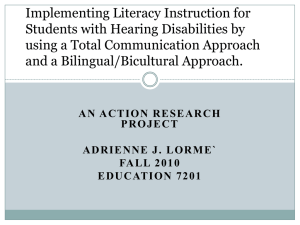
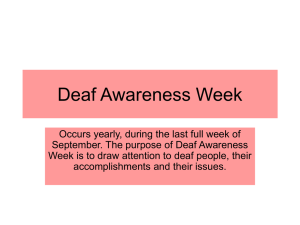

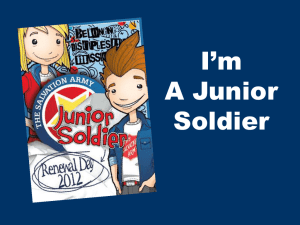
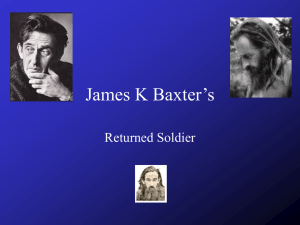

![Irish_Instruments[1]](http://s2.studylib.net/store/data/005225244_1-933d38d948219028b61a355ae6baf1c4-300x300.png)